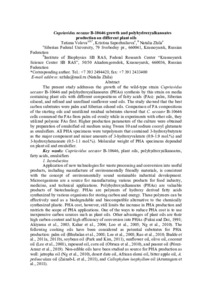Cupriavidus necator B-10646 growth and polyhydroxyalkanoates production on different plant oils
Скачать файл:
URI (для ссылок/цитирований):
https://www.sciencedirect.com/science/article/pii/S0141813020338514https://elib.sfu-kras.ru/handle/2311/142913
Автор:
Volova
Sapozhnikova
Zhila
Коллективный автор:
Институт фундаментальной биологии и биотехнологии
Базовая кафедра биотехнологии
Дата:
2020-12Журнал:
International Journal of Biological MacromoleculesКвартиль журнала в Scopus:
Q1Квартиль журнала в Web of Science:
Q1Библиографическое описание:
Volova. Cupriavidus necator B-10646 growth and polyhydroxyalkanoates production on different plant oils [Текст] / Volova, Sapozhnikova, Zhila // International Journal of Biological Macromolecules. — 2020.Текст статьи не публикуется в открытом доступе в соответствии с политикой журнала.
Аннотация:
The present study addresses the growth of the wild-type strain Cupriavidus necator B-10646 and polyhydroxyalkanoates (PHAs) synthesis by this strain on media containing plant oils with different compositions of fatty acids (FAs): palm, Siberian oilseed, and refined and unrefined sunflower seed oils. The study showed that the best carbon substrates were palm and Siberian oilseed oils. Comparison of FA compositions of the starting oils and unutilized residual substrates showed that C. necator B-10646 cells consumed the FAs from palm oil evenly while in experiments with other oils, they utilized polyenic FAs first. Higher production parameters of the culture were obtained by preparation of emulsified oil medium using Tween 80 and sodium cocoyl glutamate as emulsifiers. All PHA specimens were terpolymers that contained 3-hydroxybutyrate as the major component and minor amounts of 3-hydroxyvalerate (0.9-1.9 mol.%) and 3-hydroxyhexanoate (0.5-1.1 mol.%). Molecular weight of PHA specimens depended on plant oil and emulsifier.

